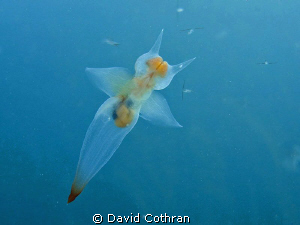|
Svalbard and Jan Mayen Islands Underwater Photo Sites This site is outside the westernmost sill in Hornsund, so it often has decent visibility and hosts a marine community more typical of the outer coast of western Spitsbergen than the fjord waters to the east. A steep shelving rock wall, mostly covered in a dense growth of Laminaria hyperborea, drops to a coarse sandy bottom at about 80 feet. Water temperature typically about 35F (2C) in July and August. Often a great site for zooplankton like pteropods, ctenophores and larvaceans. Facts about Gashamna, West Point| Dive types |  |
| Marine Life |   |
 by David CothranClione limacina, a pteropod or sea butterfly, photographed in Hornsund, Spitsbergen. There was a bizzard of zooplankton in the water that day - you can just make out some calanoid copepods in the water around the pteropod.
|